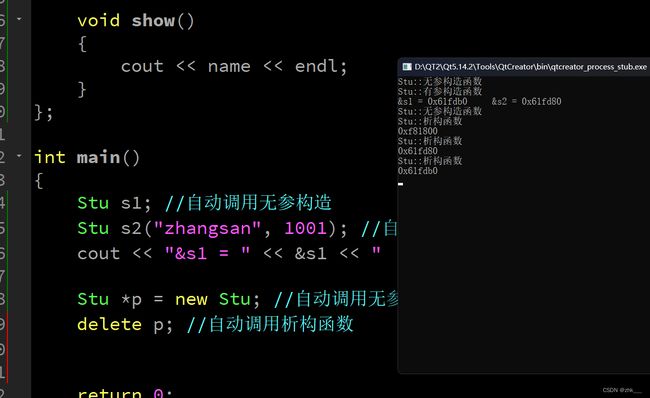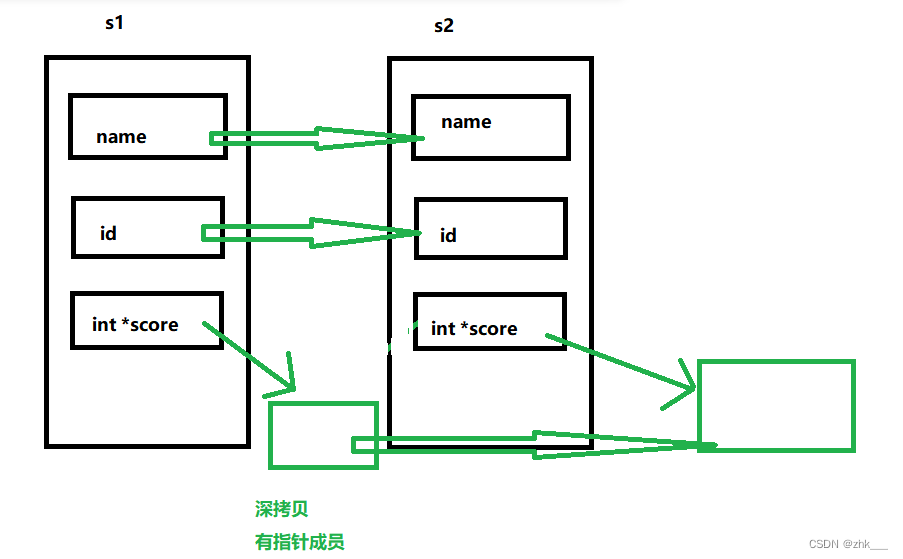嵌入式养成计划-37----C++内存动态分配与回收--C++类中特殊的成员函数
八十五、 C++内存动态分配与回收
- C语言中的动态内存分配和回收是用malloc、free来完成的
- C++中也可以用上述两个函数来完成。
- C++中也为用户提供了两个关键字来进行动态内存分配和回收 new 、delete
85.1 分配
- 单个内存分配
格式: 数据类型 *指针名 = new 数据类型- 例如: int *p1 = new int;
//此时表示在堆区中申请一个整型大小的空间,把地址赋给p
- 例如: int *p1 = new int;
- 连续内存分配
格式:数据类型 * 指针名 = new 数据类型[个数]- 例如: int *p2 = new int[5];
//在堆区中连续申请5个整型大小的空间
- 例如: int *p2 = new int[5];
85.2 回收
- 单个内存回收
格式: delete 指针名- 例如: delete p1;
- 连续内存回收
格式:delete [ ]指针名- 例如 : delete [ ]p2;
85.3 new、delete 和malloc 、free之间的区别 (笔试面试题)
- new delete 是关键字,malloc free是函数
- new申请空间是以数据类型为单位,malloc申请空间是字节单位
- new可以申请空间是初始化,malloc申请空间不会
- new申请空间是什么类型指针就是什么类型,malloc返回值是void*,需要强制转换才能使用。
- new 申请对象空间时,会自动调用构造函数,而malloc不会
- delete释放对象空间时,会自动调用析构函数,而free不会
85.4 示例:
#include 八十六、 C++类中特殊的成员函数
- 特殊函数种类: 构造函数、析构函数、拷贝构造函数、拷贝赋值函数、移动赋值、移动拷贝、取地址运算符、常取地址运算符
- 特殊原因:
- 这些函数无需程序员手动定义,系统会默认提供,如果程序员手动定义,那么系统就取消默认提供。
- 这些函数无需程序员手动调用,在特定的条件下,系统自动调用,即使是程序员手动定义的函数。
86.1 构造函数
86.1.1 功能
- 在类实例化对象时,会自动调用构造函数来给类对象申请空间以及初始化。
86.1.2 格式
- 函数名:与类同名
- 返回值:无 也无void
- 参数:可以有参数,可以无参数
- 权限:一般为public
类名(形参列表)
{
函数体内容;
}
86.1.3 调用时机
- 类实例化对象时,会自动调用构造函数。
- 栈区
- 何时实例化对象,何时调用构造函数
形式 :类名 对象(实参);
- 何时实例化对象,何时调用构造函数
- 堆区
- 何时使用new ,何时调用构造函数
示例:
#include 86.1.4 注意
- 系统会提供一个默认无参构造函数。
如果自己写了有参构造函数,会把系统提供的默认无参构造函数给屏蔽掉。
如果想使用无参构造函数,则需要显性定义出无参构造函数,否则报错。 - 构造函数中可以给定默认参数值。
86.1.5 初始化列表
- 构造函数的本身功能是完成给对象申请空间的,初始化工作是由初始化列表完成。
- 初始化列表格式:
由构造函数形参列表后的小括号后面由冒号引出类名 (形参1,形参2,形参n):成员变量1(形参1),成员变量2(形参2),······,成员变量n(形参n) - 必须使用初始化列表的情况:
- 当类中有常成员变量时,对该变量的初始化必须使用初始化列表来完成。
- 当类中有引用变量时,对该变量的初始化必须使用初始化列表来完成。
- 当类中有其他类的子对象时,对该子对象的初始化必须使用初始化列表来完成。
注意:只有构造函数才有初始化列表,其他普通函数没有初始化列表。
示例:
#include 86.2 析构函数
86.2.1 功能
- 当类对象生命周期结束后,自动调用析构函数,来对类对象回收资源(释放空间)。
86.2.2 格式
- 函数名:~类名
- 返回值:无 无void
- 参数:无参数
- 权限:一般是public
~类名()
{
函数体内容;
}
86.2.3 调用时机
- 类对象生命周期结束后,会自动调用析构函数。
- 栈区
- 当类对象所在的函数结束时,自动调用析构函数
- 堆区
- 何时使用delete ,何时调用析构函数
示例 :
#include 小结:
- 类中都系统默认提供析构函数,如果显性定义了析构函数,则系统取消默认提供。
- 当类中的成员变量有指针并且这个指针成员变量在堆区申请了空间,则此时需要显性定义析构函数,并且在析构函数中手动将指针成员所申请的空间释放,避免内存泄漏。
- 每个类中只有一个析构函数,原因:析构函数没有参数,所以不能重载。
#include 86.3 拷贝构造函数
86.3.1 功能
- 拷贝构造函数其实就是一种特殊的构造函数,用一个类对象给另一个类对象初始化的。
86.3.2 格式
- 函数名:与类同名
- 返回值:无 无void
- 参数: 同类的其他类对象
- 权限:一般为public
类名(const 类名 &other)
{
函数体内容
}
86.3.3 调用时机
- 用一个类对象给另一个类对象初始化时,自动调用拷贝构造函数
eg:
Stu s(s1);
Stu s = s1; - 当类对象作为函数的形参时, 实参传递给形参时,自动调用拷贝构造函数
- 当函数返回一个类对象时,自动调用拷贝构造函数
86.4 浅拷贝和深拷贝(笔试面试)
- 系统会提供一个默认的拷贝构造函数,如果自己显性定义出了拷贝构造函数,则系统会取消默认提供函数。
- 系统提供的拷贝构造函数,是把一个对象的所有数据成员初始化另一个对象的所有数据成员,叫浅拷贝
86.4.1 浅拷贝
86.4.2 深拷贝
86.5 拷贝赋值函数
86.5.1 功能
- 用一个类对象给另一个类对象赋值操作。
- 本质上是赋值运算符重载。
86.5.2 格式
- 函数名:operator=
- 返回值:自身的引用
- 参数:同类的其他类对象的引用
- 权限:一般为public
类名 &operator=(const 类名&other)
{
函数体内容;
}
86.5.3 调用时机
- 用一个类对象给另一个类对象赋值操作时
#include 小作业:
设计一个Per类,
类中包含私有成员:
姓名、年龄、指针成员身高、体重,
再设计一个Stu类,
类中包含私有成员:
成绩、Per类对象p1,
设计这两个类的 构造函数、 析构函数 和 拷贝构造函数。
我写的:
class.h
#ifndef __CLASS_H__
#define __CLASS_H__
#include pre.cpp
#include "class.h"
//构造函数
Pre::Pre(){
cout << this->name << " 调用了无参构造函数" << endl;
}
Pre::Pre(string name, int age, int high, int weight){
this->name = name;
this->age = age;
this->high = new int(high);
this->weight = new int(weight);
cout << this->name << " 调用了有参构造函数" << endl;
}
//析构函数
Pre::~Pre(){
delete this->high;
delete this->weight;
cout << this->name << " 调用了析构函数" << endl;
}
//拷贝构造函数
Pre::Pre(const Pre &other){
this->name = other.name;
this->age = other.age;
this->high = new int(*(other.high));
this->weight = new int(*(other.weight));
cout << this->name << " 调用了拷贝构造函数" << endl;
}
string Pre:: get_name(){
return this->name;
}
stu.cpp
#include "class.h"
Stu::Stu(){
cout << this->p.get_name() << " 调用了无参构造函数" << endl;
}
Stu::Stu(int score, Pre p){
this->score = score;
this->p = p;
cout << this->p.get_name() << " 调用了有参构造函数" << endl;
}
//析构函数
Stu::~Stu(){
cout << this->p.get_name() << " 调用了析构函数" << endl;
}
//拷贝构造函数
Stu::Stu(const Stu &other){
this->score = other.score;
this->p = other.p;
cout << this->p.get_name() << " 调用了拷贝构造函数" << endl;
}




